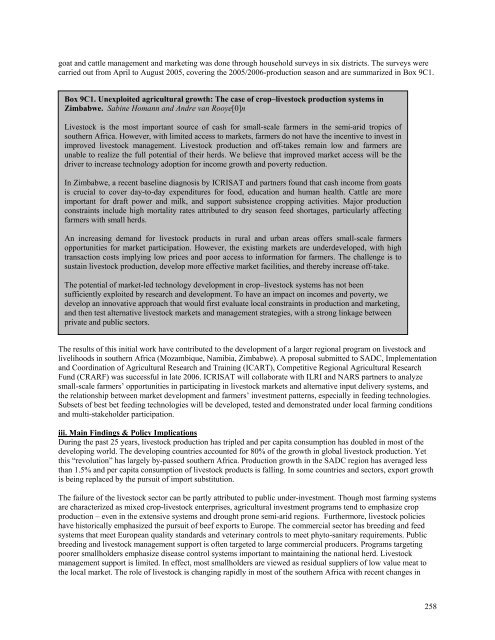ICRISAT Archival Report 2006 - The seedlings of success in the ...
ICRISAT Archival Report 2006 - The seedlings of success in the ...
ICRISAT Archival Report 2006 - The seedlings of success in the ...
Create successful ePaper yourself
Turn your PDF publications into a flip-book with our unique Google optimized e-Paper software.
goat and cattle management and market<strong>in</strong>g was done through household surveys <strong>in</strong> six districts. <strong>The</strong> surveys were<br />
carried out from April to August 2005, cover<strong>in</strong>g <strong>the</strong> 2005/<strong>2006</strong>-production season and are summarized <strong>in</strong> Box 9C1.<br />
Box 9C1. Unexploited agricultural growth: <strong>The</strong> case <strong>of</strong> crop–livestock production systems <strong>in</strong><br />
Zimbabwe. Sab<strong>in</strong>e Homann and Andre van Rooye[0]n<br />
Livestock is <strong>the</strong> most important source <strong>of</strong> cash for small-scale farmers <strong>in</strong> <strong>the</strong> semi-arid tropics <strong>of</strong><br />
sou<strong>the</strong>rn Africa. However, with limited access to markets, farmers do not have <strong>the</strong> <strong>in</strong>centive to <strong>in</strong>vest <strong>in</strong><br />
improved livestock management. Livestock production and <strong>of</strong>f-takes rema<strong>in</strong> low and farmers are<br />
unable to realize <strong>the</strong> full potential <strong>of</strong> <strong>the</strong>ir herds. We believe that improved market access will be <strong>the</strong><br />
driver to <strong>in</strong>crease technology adoption for <strong>in</strong>come growth and poverty reduction.<br />
In Zimbabwe, a recent basel<strong>in</strong>e diagnosis by <strong>ICRISAT</strong> and partners found that cash <strong>in</strong>come from goats<br />
is crucial to cover day-to-day expenditures for food, education and human health. Cattle are more<br />
important for draft power and milk, and support subsistence cropp<strong>in</strong>g activities. Major production<br />
constra<strong>in</strong>ts <strong>in</strong>clude high mortality rates attributed to dry season feed shortages, particularly affect<strong>in</strong>g<br />
farmers with small herds.<br />
An <strong>in</strong>creas<strong>in</strong>g demand for livestock products <strong>in</strong> rural and urban areas <strong>of</strong>fers small-scale farmers<br />
opportunities for market participation. However, <strong>the</strong> exist<strong>in</strong>g markets are underdeveloped, with high<br />
transaction costs imply<strong>in</strong>g low prices and poor access to <strong>in</strong>formation for farmers. <strong>The</strong> challenge is to<br />
susta<strong>in</strong> livestock production, develop more effective market facilities, and <strong>the</strong>reby <strong>in</strong>crease <strong>of</strong>f-take.<br />
<strong>The</strong> potential <strong>of</strong> market-led technology development <strong>in</strong> crop–livestock systems has not been<br />
sufficiently exploited by research and development. To have an impact on <strong>in</strong>comes and poverty, we<br />
develop an <strong>in</strong>novative approach that would first evaluate local constra<strong>in</strong>ts <strong>in</strong> production and market<strong>in</strong>g,<br />
and <strong>the</strong>n test alternative livestock markets and management strategies, with a strong l<strong>in</strong>kage between<br />
private and public sectors.<br />
<strong>The</strong> results <strong>of</strong> this <strong>in</strong>itial work have contributed to <strong>the</strong> development <strong>of</strong> a larger regional program on livestock and<br />
livelihoods <strong>in</strong> sou<strong>the</strong>rn Africa (Mozambique, Namibia, Zimbabwe). A proposal submitted to SADC, Implementation<br />
and Coord<strong>in</strong>ation <strong>of</strong> Agricultural Research and Tra<strong>in</strong><strong>in</strong>g (ICART), Competitive Regional Agricultural Research<br />
Fund (CRARF) was <strong>success</strong>ful <strong>in</strong> late <strong>2006</strong>. <strong>ICRISAT</strong> will collaborate with ILRI and NARS partners to analyze<br />
small-scale farmers’ opportunities <strong>in</strong> participat<strong>in</strong>g <strong>in</strong> livestock markets and alternative <strong>in</strong>put delivery systems, and<br />
<strong>the</strong> relationship between market development and farmers’ <strong>in</strong>vestment patterns, especially <strong>in</strong> feed<strong>in</strong>g technologies.<br />
Subsets <strong>of</strong> best bet feed<strong>in</strong>g technologies will be developed, tested and demonstrated under local farm<strong>in</strong>g conditions<br />
and multi-stakeholder participation.<br />
iii. Ma<strong>in</strong> F<strong>in</strong>d<strong>in</strong>gs & Policy Implications<br />
Dur<strong>in</strong>g <strong>the</strong> past 25 years, livestock production has tripled and per capita consumption has doubled <strong>in</strong> most <strong>of</strong> <strong>the</strong><br />
develop<strong>in</strong>g world. <strong>The</strong> develop<strong>in</strong>g countries accounted for 80% <strong>of</strong> <strong>the</strong> growth <strong>in</strong> global livestock production. Yet<br />
this “revolution” has largely by-passed sou<strong>the</strong>rn Africa. Production growth <strong>in</strong> <strong>the</strong> SADC region has averaged less<br />
than 1.5% and per capita consumption <strong>of</strong> livestock products is fall<strong>in</strong>g. In some countries and sectors, export growth<br />
is be<strong>in</strong>g replaced by <strong>the</strong> pursuit <strong>of</strong> import substitution.<br />
<strong>The</strong> failure <strong>of</strong> <strong>the</strong> livestock sector can be partly attributed to public under-<strong>in</strong>vestment. Though most farm<strong>in</strong>g systems<br />
are characterized as mixed crop-livestock enterprises, agricultural <strong>in</strong>vestment programs tend to emphasize crop<br />
production – even <strong>in</strong> <strong>the</strong> extensive systems and drought prone semi-arid regions. Fur<strong>the</strong>rmore, livestock policies<br />
have historically emphasized <strong>the</strong> pursuit <strong>of</strong> beef exports to Europe. <strong>The</strong> commercial sector has breed<strong>in</strong>g and feed<br />
systems that meet European quality standards and veter<strong>in</strong>ary controls to meet phyto-sanitary requirements. Public<br />
breed<strong>in</strong>g and livestock management support is <strong>of</strong>ten targeted to large commercial producers. Programs target<strong>in</strong>g<br />
poorer smallholders emphasize disease control systems important to ma<strong>in</strong>ta<strong>in</strong><strong>in</strong>g <strong>the</strong> national herd. Livestock<br />
management support is limited. In effect, most smallholders are viewed as residual suppliers <strong>of</strong> low value meat to<br />
<strong>the</strong> local market. <strong>The</strong> role <strong>of</strong> livestock is chang<strong>in</strong>g rapidly <strong>in</strong> most <strong>of</strong> <strong>the</strong> sou<strong>the</strong>rn Africa with recent changes <strong>in</strong><br />
258

















